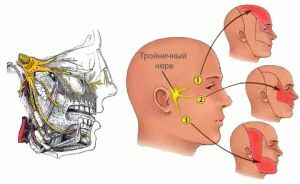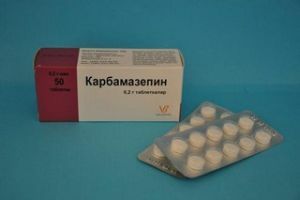 The task of nerves is to conduct impulses from the brain( head and spinal) throughout the body. Among other things, nerve impulses are responsible for the movement of muscles and the sensitivity of the skin.
The task of nerves is to conduct impulses from the brain( head and spinal) throughout the body. Among other things, nerve impulses are responsible for the movement of muscles and the sensitivity of the skin.
When the nerve is squeezed, its normal operation is disturbed and the impulse passes all the worse, the stronger the nerve is squeezed.
If you hit something hard with your elbow, you will have a slide on your finger and a sharp pain. This is the reaction of the ulnar nerve to a stroke on it. In the case when the ulnar nerve is not subjected to shock, but constant compression, there is a so-called neuropathy, that is, a violation of the nerve impulse.
Squeezing of the ulnar nerve in the area of the cubital canal is called - the syndrome of the cubital canal.
Contents of the article
- Anatomy of the
- Syndrome Causes of the
- Syndrome What does the syndrome indicate?
- Diagnostic methodologies
- Complex of treatment methods
- Non-surgical methods
- Surgical treatment
- What is needed for effective rehabilitation
- Complications
- The purpose of prevention is to avoid elbow injuries
Anatomy of the
syndrome Starting in the cervical nervous plexus, the ulnar nerve passes over the arm to the fingers. Through the elbow, the ulnar nerve passes through the cubital canal.
This channel is formed by tendons, bone( elbow and inner epicondyle) and ligament.
Therefore, if the ulnar nerve is damaged, the brushing will be difficult.
Causes of the syndrome
There are several reasons for the development of the syndrome of the cubital canal:
- It is commonly believed that the most common of these is the multiple trauma .For example, with monotonous and frequent movements on flexion-extension of the elbow during his professional activities or sports. As a result, the tendon arch becomes inflamed, its edges become thicker and the space of the canal narrows.
- The next reason is the fracture of the ulnar process or the lower humerus of the , which can change the anatomy of the cubital canal. A similar result can result in the formation of bone spurs and cysts. The syndrome of the cubital canal can develop and as a result of a strong elbow stroke.
- Another reason is the long-term pressure on the elbow of the .For example, if you ride on the car with your elbow on the door. Or if you sit at the table for a long time with an emphasis on the elbow.
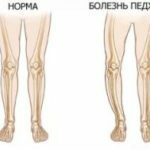 Paget's disease causes pathological destruction of bones, joints and deformity of the spine. Is it possible to avoid pathology?
Paget's disease causes pathological destruction of bones, joints and deformity of the spine. Is it possible to avoid pathology?
Complex of signs that arise due to compression of the spinal nerves radicular lumbar syndrome. How to identify and the syndrome in time to begin his treatment.
What does the syndrome indicate?
The following are the symptoms in which the syndrome of the cubital canal manifests itself most often, and it is not necessary that they are present all at once:
- feels numbness, pain and stiffness, it covers the little finger and half of the ring finger;
- painful sensations with flexion-extension of fingers, weakness of grip;
- drawing pain in the elbow area.
All these problems appear gradually and further progress. Brighter than all the symptoms are expressed in the morning, since in the dream the elbow is for a long time in a bent position without movement. 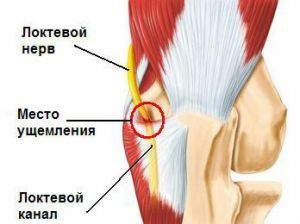
There are difficulties in the movements of the brush - it is difficult to write, print, hold something in your hand.
As a rule, the intensity of symptoms decreases after a few hours. However, if you do not start treatment on time, the problem can become more serious.
The doctor should be consulted in case the above symptoms do not go away within a month.
Diagnostic Techniques
At the initial examination the doctor should establish the level at which the ulnar nerve is squeezed.
It is determined the ability to make some movements with the brush, and the fingers are checked for sensitivity.
The is established as the TINNEL symptom ( when symptoms are amplified during a tapping on the cubital canal).
For the patient, medical examination can be very unpleasant, but it is necessary for the correct diagnosis.
Basically, just diagnosis is enough to make a diagnosis.
If a particular case is in doubt, an additional examination can be conducted. It is designed to identify the non-standard cause of the ulnar nerve compression syndrome.
For this, the following can be assigned:
- Radiography .It is designed to see bones;
- CT ( computed tomography).Also designed to show bones, only with a lot of details;
- US ( ultrasound examination);
- MRI ( magnetic resonance imaging).It is designed to see soft tissue. These include muscles, cartilage, ligaments, etc;
- EMNG ( electromyoneurography).A test that measures the rate of passage of a nerve impulse.
Complex of therapeutic methods
In case of diagnosis, the syndrome of the cubital canal is prescribed conservative treatment or an operation is performed.
Non-surgical techniques
 The goal of conservative treatment at the initial stage of the syndrome is to eliminate the causes of the onset of symptoms. It is necessary to seriously limit the load, and athletes - to stop training.
The goal of conservative treatment at the initial stage of the syndrome is to eliminate the causes of the onset of symptoms. It is necessary to seriously limit the load, and athletes - to stop training.
Also with the symptoms will help cope with the use of non-steroidal anti-inflammatory drugs.
All monotonous, repetitive movements must be deleted. It is necessary to abandon the habit of leaning on the door in the car, and so on.
But the most important thing is to exclude the execution of those movements that provoke pain .If the implementation of these movements is required to perform tasks within the framework of professional activity, it is necessary at least to maximize the number of breaks.
If the patient is sitting at a computer, you need to make sure that his elbow is not hanging and does not lean against the very edge of the table. In general, when working at a table, it is necessary to put something soft under the elbow.
It's also a good idea to use a bandage to attach a folded terry towel to the elbow bend. So the hand will bend less. It is especially useful to do this to those who sleep, bending the arm and putting it under the head.
Another important aspect of conservative treatment is the use of anti-inflammatory non-steroid drugs.
For example, it can be a voltarene-gel. They need to smear the elbow, regardless of whether the pain is there or not. In addition to anesthetic, these drugs have anti-inflammatory effect.
Namely, the inflammation of the soft tissues of the walls of the cubital canal and is the cause of nerve compression.
Vitamin B6 is also not bad.
Surgical treatment
The purpose of the surgical procedure is decompression( getting rid of squeezing) of the ulnar nerve in the cubital canal. There are several types of surgery.
In the first form of operation, a tendon arch is dissected and a part of the canal walls is removed. In some cases, partial removal of the epicondyle of the humerus is carried out.
The second type of operation is a transposition of the ulnar nerve. In this case, a completely new channel is formed, into which the  is transplanted.
is transplanted.
Which of these two methods of operation is preferable, it is difficult to say, since the statistics show their equal effectiveness.
The operation is performed either under local or general anesthesia.
What you need for effective rehabilitation
In case the conservative treatment was successful, the improvement will come in 1-1.5 months. It is not excluded that the patient will have to wear an elbow pad at night.
You will also need to monitor hand movements. Repetitive and monotonous movements of the hand and hand should be limited, and the elbow should not be in a bent position for long.
How the postoperative recovery will take place depends on the operation itself. After removal of the epicondyle, a gauze bandage will be applied to the patient around the elbow.
Recovery after this type of operation occurs quickly. During rehabilitation, motor exercises are supposed.
After the transposition, the recovery takes place more slowly. It is possible that this process will take several months. On the elbow the patient will have a tire, which will have to be worn for 3 weeks.
After the tire has been removed, the patient is shown physiotherapy, beginning with passive movements and ending with active power load.
Complications of
Complications are rare. If they do happen, they represent damage to the medial collateral ligament and / or the medial cutaneous nerve.
It is also possible that perineurium will be involved in the scar process.
The purpose of prevention is to avoid injuries to the elbow of
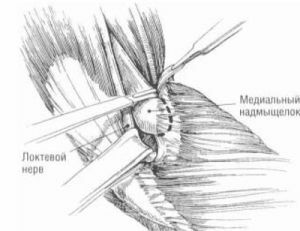 . There are no special preventive measures. You just need to exclude the possibility of traumatizing the elbow.
. There are no special preventive measures. You just need to exclude the possibility of traumatizing the elbow.
If the operation is performed correctly, then a positive effect will be necessary, although it can sometimes wait several months. Such a period is due to the fact that there is a recovery of nerve cells, and they do it slowly.
Also I must say that the improvement comes gradually, and not dramatically and at the last moment.


